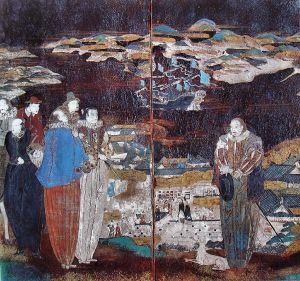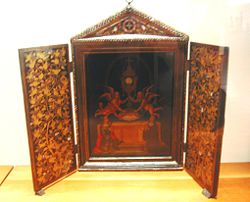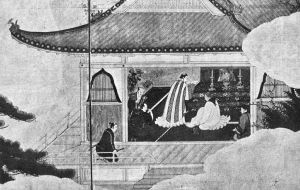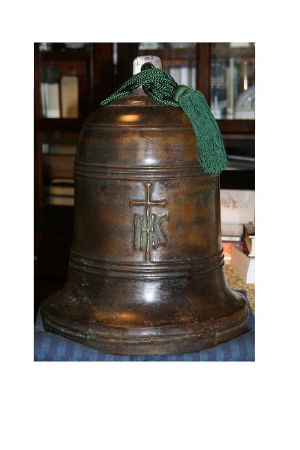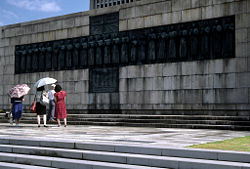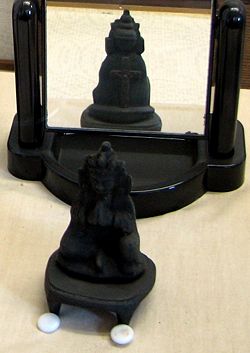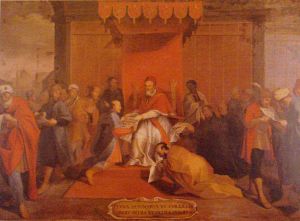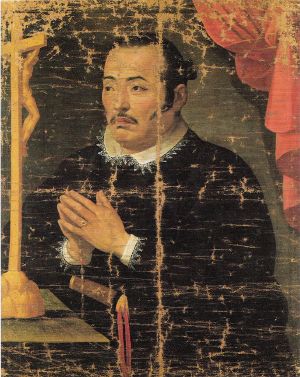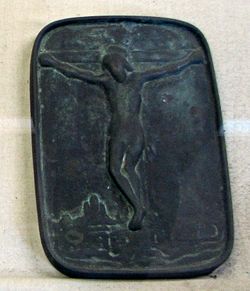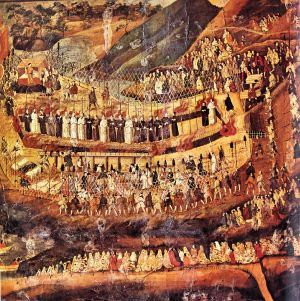Kirishitan
Kirishitan (吉利支丹, 切支丹, キリシタン), from Portuguese cristão, referred to Roman Catholic Christians in Japanese and is used as a historiographic term for Roman Catholics in Japan in the 16th and 17th centuries. Christian missionaries consisted of "fathers", or bateren from the Portuguese word “padre”, and "brothers", or iruman from the Portuguese word "irmão".
Catholic missionary activities in Japan began in 1549, exclusively performed by Portuguese-sponsored Jesuits until Spanish-sponsored mendicant orders, such as the Franciscans and Dominicans, gained access to Japan. Francisco Xavier [1][2], Cosme de Torres (a Jesuit priest), and Father John Fernandez were the first, who arrived to Kagoshima with hopes to bring Christianity and Catholicism to Japan. Catholicism was subsequently repressed in several parts of the country and ceased to exist publicly in the 17th century.
However, there are some historians who state that there is enough archaeological evidence to suggest that Nestorian (Assyrian Church) missionaries first landed in Japan in AD 199, believing that they travelled through India, China and Korea before the Tang Dynasty. It has also been estimated that the first churches were fully established by the end of the 4th century especially at Nara in central Japan.[3]
The line of demarcations between Portugal and Spain
Religion was an integral part of the state and evangelization was seen as having both secular and spiritual benefits for both Portugal and Spain. Wherever these powers attempted to expand their territories or influence, missionaries would soon follow. By the Treaty of Tordesillas, the two powers divided the world between them into exclusive spheres of influence, trade and colonization. Although at the time of the demarcation, neither nation had any direct contact with Japan, that nation fell into the sphere of the Portuguese.
The countries disputed the attribution of Japan. Since neither could colonize it, the exclusive right to propagate Christianity in Japan meant the exclusive right to trade with Japan. Portuguese-sponsored Jesuits under Alessandro Valignano took the lead in proselytizing in Japan over the objection of the Spaniards. The fait accompli was approved in Pope Gregory XIII's papal bull of 1575, which decided that Japan belonged to the Portuguese diocese of Macau. In 1588, the diocese of Funai (Nagasaki) was founded under Portuguese protection.
In rivalry with the Jesuits, Spanish-sponsored mendicant orders entered into Japan via Manila. While criticizing Jesuit activities, they actively lobbied the Pope. Their campaigns resulted in Pope Clement VIII's decree of 1600, which allowed Spanish friars to enter Japan via the Portuguese Indies, and Pope Paul V's decree of 1608, which abolished the restrictions on the route. The Portuguese accused Spanish Jesuits of working for their homeland instead of their patron. The power struggle between Jesuits and mendicant orders caused a schism within the diocese of Funai. Furthermore, mendicant orders tried in vain to establish a diocese on the Tohoku region that was to be independent from the Portuguese one.
The Roman Catholic world order was challenged by the Netherlands and England. Theoretically, it was repudiated by Grotius's Mare Liberum. In the early 17th century, Japan built trade relations with the Netherlands and England. Although England withdrew from the operations in ten years under James I due to lack of profitability, the Netherlands continued to trade with Japan and became the only European country that maintained trade relations with Japan until the 19th century. As trade competitors, the Protestant countries engaged in a negative campaign against Catholicism, and it subsequently affected shogunate policies toward the Iberian kingdoms.
Portugal's and Spain's colonial policies were also challenged by the Roman Catholic Church itself. The Vatican founded the Congregatio de Propaganda Fide in 1622 and attempted to separate the churches from the influence of the Iberian kingdoms. But it was too late for Japan. The organization failed to establish staging points in Japan.
Propagation strategy
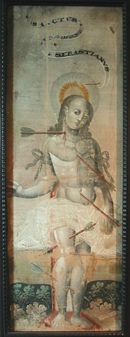
The Jesuits believed that it was very effective to seek to influence people in power and to pass the religion downward to the commoners. At least they needed to gain permission from local rulers to propagate Catholicism within their domains. It is confirmed that as feudal lords converted to Catholicism, the number of believers in their territories was drastically increased. After the edict banning Christianity, there were communities that kept practicing Catholicism without having any contact with the Church until missionaries were able to return much later.
Economic activities
The Jesuits in Japan had to maintain economic self-sufficiency because they could not expect stable and sufficient payment from their patron, the King of Portugal, the king allowing the Jesuits to engage in trade with Japan. Such economic activity can be found in the work of Francis Xavier, the pioneer of Catholic missions in Japan, who covered the cost of missionary work through merchant trading. From the 1550s to the 1570s, the Jesuits covered all necessary expenses with trade profits and bought land in India.
Their officially recognized commercial activity was a fixed-amount entry into the Portuguese silk trade between Macau and Nagasaki. They financed to a certain amount the trade association in Macau, which purchased raw silk in Canton and sold it in Nagasaki. They did not confine their commercial activity to the official silk market but expanded into unauthorized markets. For the Macau-Nagasaki trade, they dealt in silk fabrics, gold, musk and other goods including military supplies and slavery. Sometimes, they even got involved in Spanish trade, prohibited by the kings of Spain and Portugal, and antagonized the Portuguese traders.
It was mainly procurators who brokered Portuguese trade. They resided in Macau and Nagasaki, and accepted purchase commitments by Japanese customers such as; the shogunate daimyo and wealthy merchants. By brokerage, the Jesuits could expect not only rebates but also favorable treatment from the authorities. For this reason, the office of procurator became an important post amongst the Jesuits in Japan. Although trade activities by the Jesuits ate into Portuguese trade interests, procurators continued their brokerage utilizing the authority of the Catholic Church. At the same time, Portuguese merchants required the assistance of procurators who were familiar with Japanese customs, since they established no permanent trading post in Japan. Probably the most notable procurator was João Rodrigues, who approached Toyotomi Hideyoshi and Tokugawa Ieyasu and even participated in the administration of Nagasaki.
Such commercial activities were contrary to the idea of honorable poverty that the priests held. But some Jesuits at this time placed the expansion of the society's influence before this ideal. Mendicant orders fiercely accused the Jesuits of being corrupt and even considered their activity as the primary reason for Japan's ban on Catholicism. Mendicant orders themselves were not necessarily uninvolved in commercial activities.
Military activities
Missionaries were not reluctant to take military action if they considered it an effective way to Christianize Japan. They often associated military action against Japan with the conquest of China. They thought that well-trained Japanese soldiers who had experienced long civil wars would help their countries conquer China. For example, Alessandro Valignano said to the Philippine Governor that it was impossible to conquer Japan because the Japanese were very brave and always received military training but that Japan would benefit them when they would conquer China. Francisco Cabral also reported to the King of Spain that priests were able to send to China two or three thousand Japanese Christian soldiers who were brave and were expected to serve the king with little pay.
The Jesuits provided various kinds of support including military support to Kirishitan daimyo when they were threatened by non-Kirishitan daimyo. Most notable was their support of Omura Sumitada and Arima Harunobu, who fought against the anti-Catholic Ryuzoji clan. In the 1580s, Valignano believed in the effectiveness of military action and fortified Nagasaki and Mogi. In 1585, Gaspar Coelho asked the Spanish Philippines to send a fleet but the plan was rejected due to the shortness of its military capability. Christian's Protasio Arima and Paulo Okamoto were named as principles in an assassination plot to murder the magistrate in charge of the Shogunate's most important port city of Nagasaki.
When Toyotomi Hideyoshi issued the first ban on Catholicism in 1587, the Jesuits in Japan, led by Coelho, planned armed resistance. At first, they sought help from Kirishitan daimyo but the daimyo refused. Then they called for a deployment of reinforcements from their homeland and its colonies. But this plan was abolished by Valignano. Like the Kirishitan daimyo, he realized that a military campaign against Japan's powerful ruler would bring catastrophe to Catholicism in Japan. Valignano survived the crisis by laying all the blame on Coelho. In 1590, the Jesuits decided to stop intervening in the struggles between the daimyo and to disarm themselves. They only gave secret shipments of food and financial aid to Kirishitan daimyo.
In June 1592, Christian daimyo, under the leadership of Konishi Yukinaga, took full and active part in Hideyoshi's invasion of Korea and the massacre and enslavement of its people. Their behavior was indistinguishable from non-Christian Japanese forces.[4]
Following his death, it seems that the Jesuits realized that the Tokugawa shogunate was much stronger and more stable than Toyotomi Hideyoshi's administration, yet the mendicant orders relatively openly discussed military options. In the statement on the "Expulsion of all missionaries from Japan", drafted by Zen monk Konchiin Suden (1563-1633) and issued in 1614 under the name of second shogun Hidetada (1579-1632), was the considered the first official statement of a comprehensive control of Kirishitan. [5] It claimed that the Christian's were bringing disorder to Japanese society and that there followers "contravene governmental regulations, traduce Shinto, calumniate the True Law, destroy regulations, and corrupt goodness". [6] It was fully implemented and cannonized as one of the fundamental Tokugawan laws. In 1615, a Franciscan emissary of the Viceroy of New Spain asked the shogun for land to build a Spanish fortress and this deepened Japan's suspicion against Catholicism and the Iberian colonial powers behind it. Kirishitan converts took part in destroying traditional temples and shrines.
Early policy toward Catholicism
When the Jesuit priest Francis Xavier arrived, Japan was experiencing a nationwide civil war. Neither the emperor nor the Ashikaga shogun could exercise power over the nation. At first, Xavier planned to gain permission for building a mission from the emperor but was disappointed with the devastation of the imperial residence. The Jesuits approached daimyo in southwestern Japan and succeeded in converting some of these daimyo. One reason for their conversion may have been the Portuguese trade in which the Jesuits acted as brokers. The Jesuits recognized this and approached local rulers with offers of trade and exotic gifts.
The Jesuits attempted to expand their activity to Kyoto and the surrounding regions. In 1559, Gaspar Vilela obtained permission from Ashikaga Yoshiteru to teach Christianity. This license was the same as those given to Buddhist temples, so special treatment cannot be confirmed regarding the Jesuits. On the other hand, Emperor Ogimachi issued edicts to ban Catholicism in 1565 and 1568. Anyway, the orders of the emperor and the shogun were not influential.
Christians refer positively to Oda Nobunaga, who died in the middle of the reunification of Japan. He favored the Jesuit missionary Luis Frois and generally tolerated Christianity. But overall, he undertook no remarkable policies toward Catholicism. Actually, Catholic power in his domain was trivial because he did not conquer western Japan, where the Jesuits were based. By 1579, at the height of missionary activity, there were only about 130,000 converts. [7]
Toyotomi Hideyoshi and the Christian Daimyo
The situation was changed when Toyotomi Hideyoshi reunified Japan. Once he became the ruler of Japan, Hideyoshi began to pay attention to external threats, particularly the expansion of European power in East Asia. The turning point for Catholic missions was the San Felipe incident, where in an attempt to recover his cargo, the Spanish captain of a shipwrecked trading vessel claimed that the missionaries were there to prepare Japan for conquest. These claims made Hideyoshi suspicious of the foreign religion. [8] He attempted to curb Catholicism while maintaining good trading relations with Portugal and Spain, which might have provided military support to Christian Daimyo in western Japan.
By 1587, Hideyoshi had become alarmed. Not because of too many converts but rather because the hegemon learned that Christian lords reportedly oversaw forced conversions of retainers and commoners, that they had garrisoned the city of Nagasaki, that they participated in the slave trade of other Japanese and, apparently offending Hideyoshi's Buddhist sentiments, that they allowed the slaughter of horses and oxen for food. [9] He was concerned that divided loyalties might lead to dangerous rebels like the Ikkō-ikki Sect of earlier years and produced his edict expelling missionaries. However, this decree was not particularly enforced. [10]
Many Daimyos converted to Christianity in order to gain more favorable access to saltpeter, used to make gunpowder. Between 1553 and 1620, eighty-six Daimyos were officially baptized, and many more were sympathetic to the Christians. [11] From the correspondence between the Portuguese King João III and the Vatican Pope of the period, it is written that the Christian Daimyos sold women into slavery for the Jesuits' gun powder at a going rate of 50 baptized Japanese girls for a barrel of saltpeter. As many as 500,000 Japanese girls were sold on the slave markets and shipped to South America and Europe. The most powerful Christian lord, Sorin Otomo (Daimyo for the Kyūshū) was recorded to trade in medicines, pepper, gunpowder, slaves with Saint Francis Xavier, Luis de Almeida (1525-1583) and the other Jesuits, which was highly profitable for Portugal and the Roman Catholic Church for years. [12]
In 1587, Hideyoshi Toyotomi called marrano Gaspar Coelho to command to stop slave trade of Japanese women and bring back all the Japanese, immediately promulgated the "Bateren-tsuiho-rei" (the Purge Directive Order to the Jesuits) on July 24, 1587. It consists of 11 articles: "No. 10. Do not sell Japanese people to the Namban (Portuguese)." Finally by 1596, the Jesuit fathers prohibited slave trade in and outside Japan. Coelho, who brought with him modern European warships, had persistent in his request to Spain to send its Armada and prepared for war with Japan. Hideyoshi put Nagasaki under his direct rule to control Portuguese trade and in 1597, 26 Kirishitan followers were executed there on his order.
Tokugawa response
After Toyotomi Hideyoshi's death, Tokugawa Ieyasu assumed hegemony over Japan, in 1600. Like Toyotomi Hideyoshi, he disliked Christian activities in Japan but gave priority to trade with Portugal and Spain. He secured Portuguese trade in 1600. He negotiated with Manila to establish trade with the Philippines. The trade promotion made his policies toward Catholicism inconsistent. At the same time, in an attempt to wrest control of the Japan trade from the Catholic countries, Dutch and British traders advised the Shogunate that Spain did indeed have territorial ambitions, and that Catholicism was Spain's principal means. The Dutch and British promised, in distinction, that they would limit themselves to trading and would not conduct missionary activities in Japan.
The Tokugawa shogunate finally decided to ban Catholicism, in 1614 and in the mid 1600's demanded the expulsion of all European missionaries and the execution of all converts [13] This marked the end of open Christianity in Japan. The immediate cause of the prohibition was a case of fraud involving Ieyasu's Catholic vavasor, but there were also other reasons behind it. The Shogunate was concerned about a possible invasion by the Iberian colonial powers, which had previously occurred in the New World and the Philippines. Domestically, the ban was closely related to measures against the Toyotomi clan. On the other hand, some Jesuits cited "reasons of state" as the key factor; they realized the superiority of state politics over religion in Japan.
The Buddhist ecclesiastical establishment was made responsible for verifying that a person was not a Christian through what became known as the "temple guarantee system" (terauke seido). By the 1630s, people were being required to produce a certificate of affiliation with a Buddhist temple as proof of religious orthodoxy, social acceptability and loyalty to the regime.
Christian view of Kirishitan history
Non-religious researchers find it difficult to understand the motivations behind martyrdom. Instead of giving detailed accounts, they merely point out the rate of martyrdoms; the number of Christians is estimated to have been about 200,000 in 1582[14]; whereas there were likely around 1,000 known martyrs during the missionary period. In contrast, Christians attach a great importance to martyrdom and persecution, noting that countless more people were dispossessed of their land and property leading to their subsequent death in poverty.
The Japanese government used Fumie to reveal practicing Catholics and sympathizers. Fumie were pictures of the Virgin Mary and Christ. Government officials made everybody trample on these pictures. People reluctant to step on the pictures were identified as Catholics and then sent to Nagasaki. The policy of the Japanese government (Edo) was to turn them from their faith, Catholicism. If the Catholics refused to change their religion, they were tortured. Many of them still refusing to abandon their faith were executed on Nagasaki's Mount Unzen.
The Shimabara Rebellion, led by a young Christian boy named Amakusa Shiro Tokisada, took place in 1637. The Rebellion broke out over economic desperation and government oppression but later assumed a religious tone. About 27,000 people joined the uprising, but it was crushed by the shogunate after a sustained campaign. They are not considered martyrs by the Catholic Church since they took up arms for materialistic reasons. Many Japanese were deported to Macau or to the Spanish Philippines. Many Macanese and Japanese Mestizos are the mixed-race descendants of the deported Japanese Catholics. 400 were officially deported by the government to Macau and Manila, but thousands of Japanese were pressured into moving voluntarily. About 10,000 Macanese, and 3,000 Japanese were moved to Manila.
The Catholic remnant in Japan were driven underground and its members became known as the "Hidden Christians". Some priests remained in Japan illegally, including eighteen Jesuits, seven Franciscans, seven Dominicans, one Augustinian, five seculars and an unknown number of Jesuit irmao and dojuku. Since this time corresponds to the Thirty Years' War between Catholics and Protestants in Germany, it is possible that the checking of Catholic power in Europe reduced the flow of funds to the Catholic missions in Japan, which could be why they failed at this time and not before. During the Edo period, the Kakure Kirishitan kept their faith. Biblical phrases or prayers were transferred orally from parent to child, and secret posts (Mizukata) were assigned in their underground community to baptize their children, all while regional governments continuously operated Fumie to expose Christians. Drawn from the oral histories of Japanese Catholic communities, Shusaku Endo's acclaimed novel "Silence" provides detailed accounts of the persecution of Christian communities and the suppression of the Church.
Rediscovery and Return
Japan was opened to foreign interaction by Matthew Perry in 1853. It became possible to live in Japan for foreigners with Harris Treaty in 1858 . Many Christian clergymen were sent from Catholic, Protestant and Orthodox Churches, though proselytizing was still banned. In 1865, some of the Japanese who lived in Urakami village near Nagasaki visited the new Ōura Church which had been built by the Paris Foreign Missions Society (Missions étrangères de Paris) barely a month before. A female member of the group spoke to a French priest, Bernard Thadee Petitjean, and confessed that their families had kept the Kirishitan faith. Those Kirishitan wanted to see the statue of St. Mary with their own eyes, and to confirm that the priest was single and truly came from the pope in Rome. After this interview, many Kirishitan thronged toward Petitjean. He investigated their underground organizations and discovered that they had kept the rite of baptism and the liturgical years without European priests for nearly 250 years. Petitjean’s report surprised the Christian world; Pope Pius IX called it a miracle.
The Edo Shogunate's edicts banning Christianity were still on the books, however, and thus persecuted the religion up to 1867, the last year of its rule. Robert Bruce Van Valkenburgh, the American minister-resident in Japan, privately complained of this persecution to the Nagasaki magistrates, though very little action was taken to stop it. The succeeding Meiji government initially continued in this vein and several thousand people were exiled. After Europe and the U.S. began to vocally criticize the persecution, the Japanese government realized that it needed to lift the ban in order to attain its interests. In 1873 the ban was lifted, exiles returned and started to construct the Urakami Cathedral which was completed in 1895.
It was later revealed that tens of thousands of Kirishitan still survived in some regions near Nagasaki. Some officially returned to the Roman Catholic Church. Others remained apart from the Catholic Church and became known as Hanare Kirishitan, retaining their own traditional beliefs and their descendants asserting that they keep their ancestor's religion. When John Paul II visited Nagasaki in 1981, he baptized some young people from Hanare Kirishitan families.
Notable Kirishitans
- Paulo Miki (1563-1596)
- Sumitada Omura, first Christian feudal lord (1533-1587)
- Arima Harunobu, Christian name Dom Protasio, Lord of Shimabara (1567-1612)
- Yoshido Kuroda, Dom Simeao, leader of Mori forces (1546-1604)
- Yukinaga Konishi, Dom Agostinho, chief member of Hideyoshi's field staff (1556-1600)
- Dom Justo Takayama Ukon daimyo of Akashi
- Dom Leao Gamo Ujisato (1556-1595)
- Dom Agostinho Konishi
- Bizen no Gomoji, Hideyoshi daughter (1574–1634)
- Ōtomo Sōrin (大友 宗麟 1530-1587), Dom Francis, "King of Bungo" , Fujiwara no Yoshisige (藤原 義鎮) , Ōtomo Yoshishige (大友 義鎮),
- Ōtomo Yoshimune(大友 義統), Constantino,
- Ōtomo Chikaie(大友 親家), Dom Sebastin
- Ōtomo Chikamori(大友 親盛),
- Mancio Ito (伊東マンショ Itō Mansho), 伊東祐益 1570 - 1612
- Julião Nakaura (中浦ジュリアン Nakaura Jurian)
- Martinão Hara (原マルチノ Hara Maruchino)
- Miguel Chijiwa (千々石ミゲル Chijiwa Migeru)
- Hasekura Tsunenaga (支倉常長)
Notable Opponents
Asayama Nichijô (Nichijô Shonin) Nichiren priest d.1577
Konchiin Sūden (1569–1633), an influential Buddhist adviser who served the first three Tokugawa shoguns.
See also
- Kakure Kirishitan ("hidden Christian") refers to the Japanese communities that continued to secretly practice a native form of Christianity in spite of persecution. Their isolation led to their drifting away from the foreign version of the religion.
- Roman Catholicism in Japan
- Martyrs of Japan
- Nanban trade period
- Nippo jisho
- Japanese words of Portuguese origin
- Suwa Shrine (Nagasaki)
- Shusaku Endo's novel "Silence" about the 17th century suppression of the last known Japanese Christian communities.
Other publications
- John, Whitney Hall (2007). The Cambridge History of Japan. Cambridge University Press. ISBN 0521657288.
- Turnbull, Stephe (1998). The Kakure Kirishitan of Japan: A Study of Their Development, Beliefs and Rituals to the Present Day. RoutledgeCurzon. ISBN 1873410700.
- Higashibaba, Ikuo (2002). Christianity in Early Modern Japan: Kirishitan Belief and Practice. Brill Academic Publishers. ISBN 9004122907.
- Junji, Kawashima (1998). Kanto heiya no kakure Kirishitan. Sakitama Shuppankai. ISBN 487891341X.
- Elisonas, Jurgis S. A. (2007). Journey to the West. Japanese Journal of Religious Studies 34 (1): 27-66.
- Kitagawa, Tomoko (2007). The Conversion of Hideyoshi’s Daughter Gō. Japanese Journal of Religious Studies 34 (1): 9-25.
- Wakakuwa, Midori (2005). Quattro Ragazzi: Tenshō Mission of Youths and the Imperial World. Shūei-sha.
- Cooper, Michael (2005). The Japanese Mission to Europe, 1582–1590; The journey of Four Samurai Boys through Portugal, Spain and Italy. Global Oriental Ltd. ISBN 1-901903-38-9.
- Secretariat, General (2007). AN OVERVIEW OF THE HISTORY OF THE CATHOLIC CHURCH IN JAPAN, 1543-1944. Catholic Bishops' Conference of Japan. Retrieved 2007-12-22.
- Eishiro, Ito (2007). Unveiling Histories of the Tohoku District; Juan Goto and Crypto-Christians. IWATE PREFECTURAL UNIVERSITY. Retrieved 2007-12-22.
ReferencesISBN links support NWE through referral fees
- ↑ Catholic Encyclopedia, 1909 on St. Francis Xavier
- ↑ Saint Francis Xavier on Catholic Forum
- ↑ The Keikyo Institute: "Nestorian Christianity in the Tang Dynasty". http://www.keikyo.com
- ↑ Kiernan, Ben (2007). Blood and Soil. Yale Univ Press. ISBN 0-30010-098-1. “About 150,000 Japanese troops landed in Korea in May-June 1592, spearheaded by the Christian daimyo Konishi Yukinaga and his division of 18,000 coreligionists. The Japanese tried to wipe out the Korean forces, and massacres proliferated. They took 8,000 heads, putting “every one who showed a sign of resistance to the edge of the sword.” Two days later, Konishi attacked Tongnae, defended by 20,000 Korean troops. At a cost of 100 Japanese killed, he “filled the fosse with five thousand dead.” On May 31, Kato took Kong-ju, “putting three thousand Koreans to the sword.” On the same day a third division of 12,000, under the Christian daimyo Kuroda, attacked Kimhae, “inflicting terrific damage on the enmy” and killing thousands more at Seishiu. Pushing north in early June, Konishi's forcees killed another 3,000-8,000 Korean troops in the Choryong pass...Three Japanese divisions had killed 15,000-20,000 Korean soldiers in three weeks. A Japanses general's war memoirs testified to the burial of 185,738 Korean and 29,014 Chinese “heads.” Japanese forces also seized over 100,000 Korean artisans and scholars and perhaps 50,000-60,000 women, and forcibly transported them to Japan or sold them as slaves abroad.”
- ↑ Higashibaba, Ikuo (2001). Christianity in Early Modern Japan: Kirishitan Belief and Practice. Brill Academic Publishers, Incorporated. ISBN 9-00412-290-7. “The Kirishitan band happened to reach Japan. Not only have they sent merchant vessels to exchange commodities, but they also spread a pernicious doctrine to confuse the right ones, so thay they would change the government of the country and own the country. This will become a great catastrophe. We cannot but stop it.”
- ↑ Shimizu, Hirokazu (1977). Kirishitan Kankei Hosei Shiryo Shu.
- ↑ L. Walker, Brett (Fall 2002). Foreign Affairs and Frontiers in Early Modern Japan: a Historio-graphical Essay. Early Modern Japan: an Interdisciplinary Journal 10 (2): 44-62.
- ↑ Cooper, Michael (1974). Rodrigues the Interpreter= An Early Jesuit in Japan and China. Weatherhill, New York, 160. ISBN 0-83480-319-4. “I have received information that in your kingdoms the promulgation of the law, i.e. Christianity, is a trick and deceit by which you overcome other kingdoms, he wrote in a letter to the Philippines in reply to the embassy led by Navarrete Fajardo in 1597. Christian missionaries, in Hideyoshi's mind, represented the first wave of European imperialism.”
- ↑ Elison, George (1973). Deus Destroyed; The Image of Christianity in Early Modern Japan. Harvard University Press, 54 and 64. ISBN 0-67419-962-6.
- ↑ Nosco, Peter (1993). Secrecy and the Transmission of Tradition, Issues in the Study of the 'Underground Christians. Japanese Journal of Religious Studies 20 (1): 3-30.
- ↑ Toshihiko, Abe (1998). Japan's Hidden Face. Bainbridgebooks/Trans-Atlantic Publications. ISBN 1-8916-960-5X.
- ↑ Onizuka, Hideaki (2006). The Rosary of the Showa Emperor. Bainbridgebooks/Trans-Atlantic Publications, 225. ISBN 4-88086-200-2. “Japan would exchange a barrel of gunpowder for fifty slaves. (In this case it would be specified as white-skinned (light skinned) good –looking (pleasing to the eyes) young Japanese women/maidens) In the name of God, if Japan can be occupied/possessed I am sure the price can be increased.”
- ↑ Mullins, Mark R. (1990). Japanese Pentecostalism and the World of the Dead: a Study of Cultural Adaptation in Iesu no Mitama Kyokai. Japanese Journal of Religious Studies 17 (4): 353-374.
- ↑ Catholic Encyclopedia on Japan
External links
- History of the Japanese Catholic Church by the Daughters of St. Paul convent; Tokyo, Japan
- Pilgrimage Sites and Churches in Nagasaki by TCA (Think Catholic Asia) Japan located inside Nagasaki Catholic Center
- 2008 Beatification of Japanese Martyrs.
| ||||||||
Credits
New World Encyclopedia writers and editors rewrote and completed the Wikipedia article in accordance with New World Encyclopedia standards. This article abides by terms of the Creative Commons CC-by-sa 3.0 License (CC-by-sa), which may be used and disseminated with proper attribution. Credit is due under the terms of this license that can reference both the New World Encyclopedia contributors and the selfless volunteer contributors of the Wikimedia Foundation. To cite this article click here for a list of acceptable citing formats.The history of earlier contributions by wikipedians is accessible to researchers here:
The history of this article since it was imported to New World Encyclopedia:
Note: Some restrictions may apply to use of individual images which are separately licensed.
